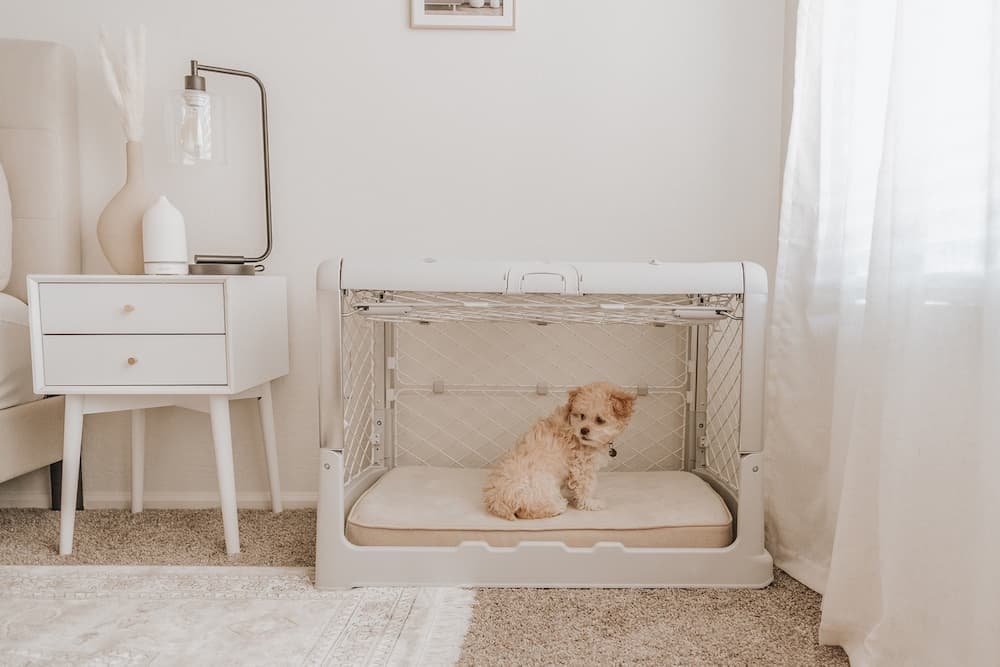How to Build a Dog’s Confidence

When you take your dog to a new destination does he bound out of the car when you arrive, ready to take in the sights? Or does he hover behind you with a tucked tail? Or what happens when a new friend comes to your house for a visit? Does your pup greet that person with a wiggle or hide and refuse to say hello at all?
Canine confidence is more than just strolling down the sidewalk with tail-wagging swagger. A confident dog is able to face unfamiliar situations and respond appropriately, and also bounce back from uncomfortable or scary situations with ease. A dog’s ability to be confident is a mix of nature and nurture. Some dogs might be genetically predisposed to be more unsure about new situations and people despite undergoing socialization during the critical period in puppyhood.
Happily, there are lessons you can teach and ways you can support your pooch to encourage building up confidence in dogs.
Why is a Dog’s Confidence Important?
Being confident means that your dog can take life’s daily stressors in stride. For example, instead of cowering and hiding when a pot accidentally crashes to the ground in the kitchen, a confident dog might startle then go right back to what he was doing. However, an unconfident dog might be reluctant to even approach the kitchen after that kind of fright.
Fear, discomfort and similar reactions causes a spike in various stress hormones in dogs, like cortisol. Obviously, life has stressors and most dogs are equipped to deal with occasional increases in cortisol. However, dogs that are under frequent stress and deal with frequent spikes in stress hormones are at risk for health problems like loss of appetite, vomiting, diarrhea, and a negatively impacted immune system that could make them susceptible to disease.
Not only that, an unconfident dog might respond to challenges with behaviors that can be difficult for pet parents to understand and respond to appropriately, like cowering, nervous vocalizations or even reactivity. Unfortunately, many behaviors rooted in stress can be misconstrued for aggressive responses.
How to Build a Dog’s Confidence

Because these confidence-building protocols are positive and dog-friendly, they work for dogs of all ages and temperaments. But these techniques will be particularly helpful for dogs needing a confidence boost.
Let Your Dog Take the Lead
Dogs are dependent on us for nearly everything—from meals to walks to companionship. So it’s important that your dog understands that he has some control over his life, and that includes how he interacts with the world around him.
Whether it’s meeting new people or visiting unfamiliar spots, always allow your dog the opportunity to explore on his own terms. If your neighbor wants to hug your dog to say hello but your dog seems reluctant, get a raincheck. If your dog seems unsure of himself at an outdoor market, don’t force him to stay and shop. Letting your dog set the pace for interactions allows him to understand that he’s not going to be forced into uncomfortable scenarios.
See the World From Your Dog’s Perspective
Some canine confidence busters might surprise you, and by observing the world the way your dog does, you’ll be better able to pick up on them and defuse them before they become a problem.
For example, your dog might be reluctant to enter a new room that has a ceiling fan if he’s never encountered one before. Or maybe your dog is nervous to meet a stranger with a beard who’s wearing a hat and sunglasses.
Rather than assuming that your dog is being stubborn or unfriendly, take a step back and try to experience what he’s going through. This can make you more empathetic to potential stressors. Positive training will help your dog learn to feel more comfortable and in time will actually change his emotional response in situations where he’s unsure.
Use Positive Training Methods
There’s nothing quite like the confidence boost that comes from learning new skills as a team. Training your dog using fun, dog-friendly techniques can help him better understand how to navigate our world. This will give him the confidence to make the right kinds of decisions.
Plus, basic training techniques are a great go-to in situations where your dog might feel unsure of himself. For example, if your pooch is worried about someone rolling by on a skateboard, ask him to do a “watch” and focus on you instead!
How to Build Confidence in a Fearful Dog

If you have a fearful dog who seems to have confidence issues, you need to take special care when trying to build his confidence. These behaviors could be due to socialization issues or a traumatic incident. A fearful dog can benefit from the previous suggestions, as well as the following tips:
Determine Your Dog’s Triggers
Dogs that are fearful often have predictable triggers that cause them to tip over into reactivity or withdrawal. Identifying each one and taking the steps to reduce the severity of your dog’s responses to them will help build up a dog’s confidence by showing him that the trigger isn’t scary after all.
For example, your dog might be fearful of people coming into the room unexpectedly, or the sound of loud voices. Using science-based training techniques like counterconditioning and desensitization using positive reinforcement will help your dog understand that the triggers aren’t scary after all.
Understand Body Language
Our canine companions communicate how they’re feeling through dog body language, and learning what your dog is saying, particularly when stressed, will enable you to help defuse the situation before it gets worse.
Unfortunately, many humans either misinterpret what a dog is saying, like assuming that a wagging tail means a dog is happy. Pet parents also miss some of the more fleeting behaviors that signal stress or fear, like subtle eye and mouth movements. By learning the mechanics of how dogs convey emotions through body language and watching your dog closely you’ll be able to deescalate potentially troubling scenarios before they get out of control.
Teach Your Dog “Touch”
“Touch” or targeting is one of those simple behaviors to teach that seems like a game but actually has helpful, real-world applications. Targeting is simply getting your dog to place a body part, usually a nose or paw, against something, like your palm.
This behavior is helpful to draw your dog’s focus away from something scary—like if your dog is reacting to a new holiday decoration on your neighbor’s lawn.
To teach it, simply present your open palm to your dog and when he moves in close to sniff it mark the behavior with a word like “yes!” then follow up with a treat. Once your dog is touching your palm consistently you can “name” the behavior by saying “touch” as he does it. Then, graduate to presenting your palm and asking for the behavior.
Finally, take the behavior on the road and try it out in non-stressful situations to start to generalize it. Pairing this simple trick with something scary can actually change your dog’s emotional response to the stressor over time.
Building Your Dog’s Confidence: The Bottom Line
Helping your dog feel confident is an important part of pet parenthood. Acting as your dog’s advocate and understanding what your dog is trying to say to you will do wonders to grow his confidence as well as your bond.
Always use positive training methods and avoid getting frustrated or angry, since this could have a negative impact and reinforce fearful or aggressive behavior.
If you’ve tried the techniques above and still feel like your dog is fearful or his confidence level isn’t where it should be, contact a certified dog trainer or a veterinary behaviorist to work with you on developing a plan that will fit your dog’s specific needs and lifestyle.








